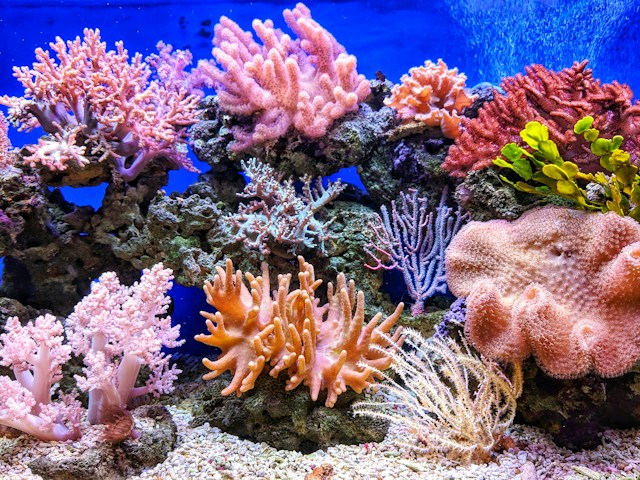What’s the Correct Way to Introduce New Species into a Coral Reef Tank?

Have you ever wondered how to add new life to your aquarium in a way that will ensure they thrive? The secret lies in understanding the delicate balance of a coral reef tank. This article will guide you on how to introduce new fish, corals, and other aquatic organisms into your reef tank.
Gathering the Essentials
Before you even think about adding new species into your tank, it’s crucial to gather all the materials you’ll need. This will save you a lot of time and hassle during the actual introduction process. The primary elements you’ll need include a quality reef tank, well-chosen corals, good lighting, rock formations for cover, and, of course, the fish and other aquatic life you plan to introduce.
Sujet a lire : Creating a safe garden for your pet
Firstly, good lighting is crucial in any reef tank. It aids in photosynthesis for your corals and provides an aesthetic appeal to your tank. When choosing a light source, the best options are LED lights as they offer a range of color temperatures and intensities, imitating the natural sunlight underwater.
Rock formations are equally important. They not only provide hideaways for your fish but also serve as a foundation for your corals. Live rocks are the best option as they contain beneficial bacteria and organisms, which help in maintaining the water quality.
A lire en complément : What Are the Health Implications of Overbreeding in Pet Rabbits?
The water in your tank should be saltwater, as many of the species you’ll be introducing are native to this environment. Always keep a water testing kit at hand to regularly check the condition of your tank water.
Selecting the Right Tank Occupants
Now that you have all the essentials in place, it’s time to select the species you’ll be introducing into your tank. A common mistake among aquarium enthusiasts is introducing species that may not be compatible with each other or with the conditions in the tank.
For a start, look for corals that are hardy and easy to care for. Soft corals like mushroom corals, star polyps, and leather corals are usually a good choice for beginners.
In terms of fish, it’s important to consider their size, temperament, and dietary needs. Generally, smaller, peaceful fish that feed on algae and other tank detritus are the best to start with. Cardinalfish, clownfish, and gobies are often recommended for newbie reef tank keepers.
Gradually Introducing the New Species
Once you’ve selected your desired species, the next step is introducing them into your tank. This process needs to be gradual to allow the new arrivals time to acclimatize to their new environment.
Place your corals and fish into a quarantine tank first to observe them for any signs of disease or stress. This additional step ensures that you’re not introducing any potential threats into your main tank.
After a quarantine period of about two weeks, you can then begin the process of introducing the new species into your main tank. Start with the corals first, as they are less mobile and will need time to attach themselves to the rocks.
Ongoing Maintenance and Care
Adding the new species into your tank is just the beginning. Constant care and maintenance are required to ensure that your tank inhabitants remain healthy and thriving.
Regularly check the water conditions of your tank. The temperature, salinity, and pH levels should be kept consistent. Any drastic changes can cause stress to your tank inhabitants and lead to disease or even death.
Algae growth can also be a problem in reef tanks. While some amount of algae is beneficial as it provides food for some species, too much can be harmful. Regular cleaning can help to keep algae levels in check.
Creating a Thriving Coral Reef Ecosystem
There’s no doubt that maintaining a coral reef tank takes time and effort. However, the sight of a well-kept, thriving tank is a reward in itself. The key is to be patient, consistent, and always be ready to learn and adapt to your tank’s needs.
Remember, always research thoroughly before introducing a new species into your tank. Monitor them regularly, noting any changes in behavior or health. A well-maintained tank can provide a home for your aquatic species for years to come and serve as a stunning addition to your living space.
Essential Tips for a Healthy Coral Reef Tank
After introducing the new species into your tank, the work doesn’t stop there. To create a thriving ecosystem, it’s important to remain diligent in observing and caring for your aquarium. Here are some essential tips to help maintain a healthy saltwater aquarium.
Aquarium supplies play a crucial role in the ongoing maintenance of your aquarium. Tools such as water heaters, thermometers, refractometers, and testing kits can help to maintain optimum water conditions. Regular testing of the water is essential to monitor the health of your aquarium’s inhabitants.
The tank size is of paramount importance for the wellbeing of your aquatic life. Crowding can lead to stress and disease in your fish. A general rule of thumb is that for every inch of fish, you should have a gallon of water. This ensures that your fish have plenty of room to swim and grow.
Feeding is also an essential aspect of caring for your saltwater fish. Be aware of the dietary needs of each species in your tank and try to provide a balanced diet. Overfeeding can cause poor water quality, so it’s better to feed in small amounts multiple times a day.
In case you notice any signs of disease or abnormal behavior, having a quarantine tank at the ready will help to isolate the affected fish and avoid a potential outbreak.
Lastly, remember to regularly clean your tank. Algae, uneaten food, and waste can accumulate over time, leading to poor water quality and potentially harming your aquarium fish.
Conclusion: The Joy of a Reef Aquarium
Maintaining a thriving reef aquarium can be a rewarding pastime. The sight of your aquatic life interacting, the soft corals swaying gently in the current, and the vibrant colors of the fish can be an escape into the wonders of the underwater world.
However, this hobby comes with a responsibility. The health and well-being of the occupants of your reef tank depend largely on your efforts. It requires patience, diligence, and a willingness to learn.
In addition to providing an attractive addition to your living space, a reef tank is also an ongoing lesson in biology and ecology. It’s a small window into the complex and fragile ecosystem of a coral reef.
Remember, every addition to your tank is a long-term commitment. Thorough research, regular monitoring, and attention to detail can ensure a healthy and vibrant reef aquarium that can provide enjoyment for years to come.
The sight of your thriving reef rock, softly illuminated under the warm glow of your tank lights, with your fish darting in and out of the charmingly arranged corals, serves as a testament to your dedication and care. As a reef tank keeper, your commitment to preserving a slice of the ocean’s beauty contributes to the wider understanding and appreciation of our planet’s aquatic life.
So whether it’s your first time setting up a reef tank or you’re an experienced diver den, the joy of maintaining a reef tank is in the journey and not just the destination. Every challenge you overcome, every new species you introduce, and every little success you achieve in maintaining your tank’s water quality only adds to the rewarding experience of this fulfilling hobby.
